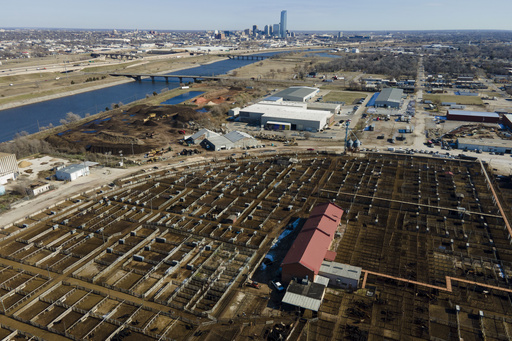
Oklahoma City is bustling with modernity, featuring upscale hotels and chic dining spots, yet on its outskirts lies an emblematic reminder of its western roots: one of the largest cattle stockyards in the world. However, the future of this landmark is uncertain.
The Oklahoma National Stockyards, the last significant stockyard located within a major city in the United States, has been put up for sale for $27 million. This price encompasses 100 acres of valuable land along the Oklahoma River, situated in a rapidly growing metropolitan area of approximately 700,000 residents. Noteworthy developments, including a new state-of-the-art NBA arena and plans for an impressive skyscraper, underscore the area’s potential for redevelopment. While the owners are hopeful that a new buyer will maintain the cattle operations, they are aware of the land’s appeal for alternative uses.
The sale reflects the ongoing changes within the livestock auction market and the broader cattle industry, which faces significant challenges. Issues such as drought, increasing production costs, and an alarming decrease in the national cattle inventory—at its lowest since the 1950s—have all contributed to the difficulties in this sector. Moreover, uncertainty brought about by tariffs imposed during the Trump administration on imported goods continues to loom over this landscape. Even though the U.S. remains the world’s leading beef producer, it simultaneously ranks among the largest net exporters of beef, with Canada and Mexico being the primary sources of imports.
According to Jerry Reynolds, president of the stockyard, the number of cattle sold at the facility has declined by about 20% over the past two years, highlighting the industry’s struggles. While the stockyard has been family-owned since 1910, the younger generations show little interest in managing a large operation that requires constant attention and resources for the care of tens of thousands of animals sold weekly.
“The signs have been evident for some time, as urban growth increasingly surrounds such facilities,” commented Derrell Peel, an agriculture economics professor at Oklahoma State University. “Not only does this land hold significant real estate value, but the operational challenges of a stockyard within a busy city environment can also be demanding.”
The stockyards were listed for sale in October, but the owners have not established a timeline for the sale’s completion. About 10,000 cattle continue to pass through the stockyard weekly, making it a unique relic in an industry that is primarily rural. This facility stands as one of the largest stocker and feeder cattle markets globally and represents one of the last remaining “terminal markets” where cattle are gathered, sold, and processed.
Historically, stockyards flourished in larger cities such as Chicago, Kansas City, and Fort Worth. However, advancements in refrigeration and rising urban property values have gradually shifted these operations to rural areas closer to feedlots and processing plants. Should the Oklahoma City stockyard close, the Joplin, Missouri auction market is likely to become the largest in the U.S., alongside another significant facility in El Reno, Oklahoma, situated to the west of the metro area.
Chris Bakwin, who is part of the family that originally established the stockyards and serves as the chairman of its board, expressed his sentiments regarding the potential sale. “As a member of a family that has been connected to this establishment for 115 years, I naturally have strong feelings about its future,” he said. “However, the ultimate goal is to consider what is most beneficial for our shareholders.”
The stockyard, with its original brick flooring laid over a century ago, offers a unique view from a metal catwalk above. Visitors can experience the lively atmosphere as cowboys corral the cattle, their hooves creating a rhythmic sound while auctioneers engage bidders in a fast-paced environment.
On a typical morning in January, rancher Garrison Duke and his family traveled from their ranch in Lexington, hauling a trailer full of cattle to the stockyard. For Duke, visiting the facility has been a cherished tradition dating back to his childhood with his father. “It was always exciting to see the cattle and experience how everything worked,” he reflected. “We hope to keep this tradition alive for our kids.”
Surrounding the stockyard is a lively business district featuring shops that highlight western heritage, including hat stores, saddlery outfits, and tempting steakhouses. This area has evolved into a sought-after destination for those looking to embrace a slice of Americana in the heart of the U.S.
With Oklahoma City experiencing a 3% population growth in recent years, the city has risen to become the 20th largest in the nation. Despite the decline of stockyards in many urban centers, the city’s mayor, David Holt, remains optimistic. “Oklahoma City is geographically extensive, which gives the stockyard the potential to thrive even in an expanding urban landscape,” he shared.
However, uncertainty still looms among those whose livelihoods are tied to the stockyard. Jason Baker, who operates one of the nine commission firms that frequent the facility, expressed his concern: “The apprehension is certainly present. This stockyard is vital for my family. Our livelihood depends on it.”

